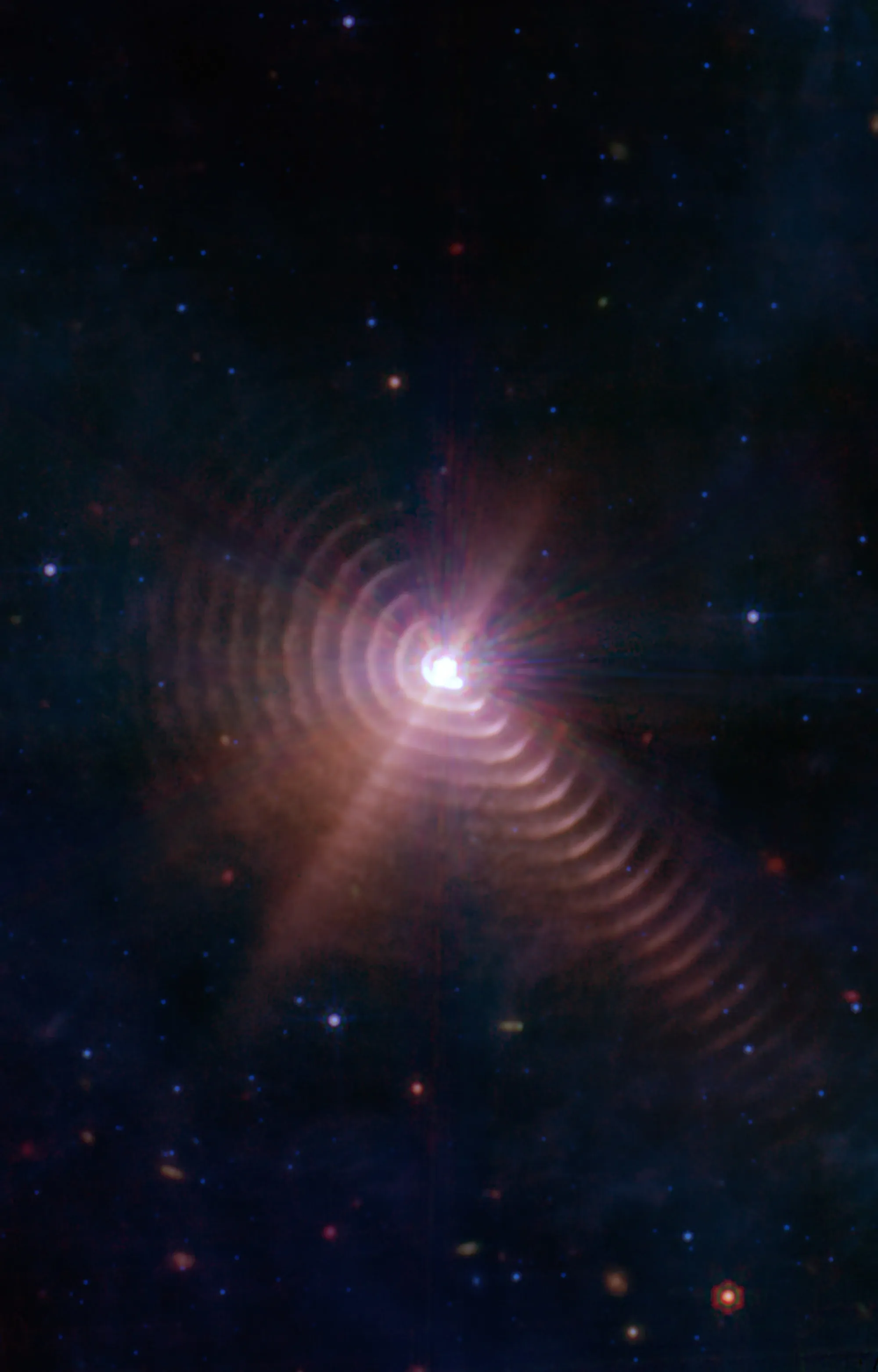WR140 Spiderweb Star System
In a complementary study of WR140, published in Nature Astronomy, NASA's James Webb Space Telescope (JWST) was able to see much deeper to snap an image of not just a single accelerating dust plume, but almost 20 of them, nested inside each other like a giant set of onion skins.
WR140 is comprised of a huge Wolf-Rayet star and an even bigger blue supergiant star, gravitationally bound in an eight-year orbit. This binary star, in the Cygnus constellation, has been monitored for two decades with one of the world's largest optical telescopes at the Keck Observatory in Hawaii.
WR140 episodically puffs out plumes of dust stretching thousands of times the distance from the Earth to the Sun. These dust plumes, produced every eight years, give astronomers a unique opportunity to observe how starlight can affect matter.
It's known that light carries momentum, exerting a push on matter known as radiation pressure. Astronomers often witness the outcome of this phenomenon in the form of matter coasting at high speed around the cosmos, but it's been a difficult process to catch in the act. Direct recording of acceleration due to forces other than gravity is rarely witnessed, and never in a stellar environment like this.
"It's hard to see starlight causing acceleration because the force fades with distance, and other forces quickly take over," said Yinuo Han from Cambridge's Institute of Astronomy, first author of the Nature paper. "To witness acceleration at the level that it becomes measurable, the material needs to be reasonably close to the star or the source of the radiation pressure needs to be extra strong. WR140 is a binary star whose ferocious radiation field supercharges these effects, placing them within reach of our high-precision data."
All stars generate stellar winds, but those from Wolf-Rayet stars can be more like a stellar hurricane. Elements such as carbon in the wind condense out as soot, which remains hot enough to glow bright in the infrared. Like smoke in the wind, this gives telescopes something that can be observed.
The team used an imaging technology known as interferometry which was able to act like a zoom lens for the 10-metre Keck telescope mirror, enabling the researchers to recover sufficiently sharp images of WR140 for the study.
Han and his team found that the dust does not stream out from the star with the wind in a hazy ball. Instead, the dust forms where the winds from the two stars collide, on the surface of a cone-shaped shock front between them.
Because the orbiting binary star is in constant motion, the shock front also rotates. The sooty plume gets wrapped into a spiral, in the same way that droplets form a spiral in a garden sprinkler.
The researchers found that WR140 has other tricks up its sleeve. The two stars are not on circular but rather elliptical orbits, and dust production turns on and off as the binary nears and departs the point of closest approach. By modelling these effects into the three-dimensional geometry of the dust plume, the astronomers were able to measure to location of dust features in three-dimensional space.
"Like clockwork, this star puffs out sculpted smoke rings every eight years, with all this wonderful physics written then inflated in the wind like a banner for us to read," said co-author Professor Peter Tuthill from the University of Sydney. "Eight years later as the binary returns in its orbit, another appears the same as the one before, streaming out into space inside the bubble of the previous one, like a set of giant nested Russian dolls."
Because the dust produced by this Wolf-Rayet is so predictable and expands to such large distances, it offered the astronomers a unique laboratory to examine the acceleration zone.
"In the absence of external forces, each dust spiral should expand at a constant speed," said Han, who is also a co-author on the JWST paper. "We were puzzled at first because we could not get our model to fit the observations, until we finally realised that we were seeing something new. The data did not fit because the expansion speed wasn't constant, but rather that it was accelerating. We'd caught that for the first time on camera."
"In one sense, we always knew this must be the reason for the outflow, but I never dreamed we'd be able to see the physics at work like this," said Tuthill. "When I look at the data now, I see WR140's plume unfurling a like giant sail made of dust. When it catches the photon wind streaming from the star, like a yacht catching a gust, it makes a sudden leap forward."
With JWST now in operation, researchers can learn much more about WR140 and similar systems. "The Webb telescope offers new extremes of stability and sensitivity," said Ryan Lau who led the JWST study. "We'll now be able to make observations like this much more easily than from the ground, opening a new window into the world of Wolf-Rayet physics."

- The research was funded in part by the Gates Cambridge Trust.
Written by Sarah Collins for Cambridge University News
Photo by NASA, ESA, CSA, STScI, JPL-Caltech
